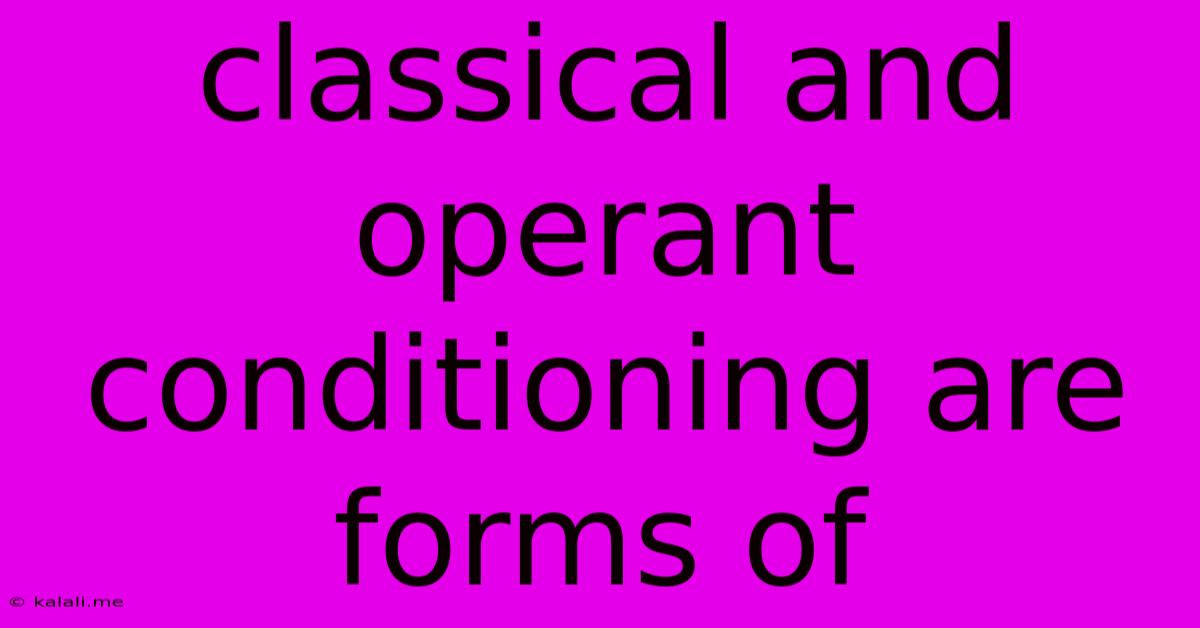Classical And Operant Conditioning Are Forms Of
Kalali
Jun 14, 2025 · 3 min read

Table of Contents
Classical and Operant Conditioning: Forms of Associative Learning
Classical and operant conditioning are both fundamental forms of associative learning. Associative learning refers to the process by which an organism learns to connect two or more stimuli or events. Understanding this core principle helps explain how we learn a vast array of behaviors and responses, from simple reflexes to complex cognitive processes. This article will delve into the specifics of each type of conditioning, highlighting their differences and illustrating them with relatable examples.
What is Classical Conditioning?
Classical conditioning, also known as Pavlovian conditioning, involves learning through association between two stimuli. A neutral stimulus (NS) becomes associated with an unconditioned stimulus (UCS) that naturally elicits an unconditioned response (UCR). Through repeated pairings, the neutral stimulus transforms into a conditioned stimulus (CS), eliciting a conditioned response (CR) similar to the UCR.
Think of Pavlov's famous experiment with dogs:
- UCS: Food (naturally elicits salivation)
- UCR: Salivation (natural response to food)
- NS: Bell (initially neutral; doesn't elicit salivation)
After repeatedly pairing the bell (NS) with the food (UCS), the dogs began to salivate (CR) at the sound of the bell (CS) alone, even without the presence of food. This demonstrates the formation of an association between the bell and the anticipation of food.
Other examples of classical conditioning include:
- Fear responses: A child who is bitten by a dog (UCS – bite, UCR – fear) may develop a fear of all dogs (CS) later on.
- Taste aversion: Eating spoiled food (UCS – spoiled food, UCR – nausea) can lead to an aversion to that particular food (CS) in the future.
- Advertising: Pairing a product (CS) with positive emotions or attractive celebrities (UCS) can create positive associations with the product in consumers' minds.
What is Operant Conditioning?
Operant conditioning, pioneered by B.F. Skinner, focuses on learning through consequences. Behaviors are strengthened or weakened depending on the consequences they produce. This involves associating a specific behavior with a particular outcome.
There are four key consequences:
- Positive Reinforcement: Adding a desirable stimulus to increase the likelihood of a behavior. Example: Giving a dog a treat (positive stimulus) for sitting (behavior).
- Negative Reinforcement: Removing an undesirable stimulus to increase the likelihood of a behavior. Example: Taking away chores (undesirable stimulus) when a child gets good grades (behavior).
- Positive Punishment: Adding an undesirable stimulus to decrease the likelihood of a behavior. Example: Giving a child a time-out (undesirable stimulus) for hitting their sibling (behavior).
- Negative Punishment: Removing a desirable stimulus to decrease the likelihood of a behavior. Example: Taking away a teenager's phone (desirable stimulus) for breaking curfew (behavior).
Operant conditioning is widely used in:
- Animal training: Training animals through rewards and punishments to perform specific tricks or behaviors.
- Behavior modification therapy: Helping individuals change undesirable behaviors by altering the consequences associated with those behaviors.
- Education: Using rewards and feedback to motivate students and reinforce learning.
Key Differences and Similarities
While both are forms of associative learning, classical and operant conditioning differ significantly:
| Feature | Classical Conditioning | Operant Conditioning |
|---|---|---|
| Type of Learning | Association between two stimuli | Association between behavior and consequence |
| Response | Involuntary, reflexive | Voluntary, operant |
| Focus | Stimulus-response | Behavior-consequence |
| Timing | Stimulus precedes response | Response precedes consequence |
Despite their differences, both classical and operant conditioning play crucial roles in shaping behavior. They often work together in complex learning processes, influencing our responses and actions in various contexts. Understanding these principles offers valuable insights into human and animal behavior and provides tools for modifying behaviors effectively.
Latest Posts
Latest Posts
-
Find Equation Of Plane Through Point And Parallel To Plane
Jun 14, 2025
-
1 Mole Of O2 In Grams
Jun 14, 2025
-
What Are All Factors Of 8
Jun 14, 2025
-
Choose The Correct Html Element For The Largest Heading
Jun 14, 2025
-
Light Wave Is Longitudinal Or Transverse
Jun 14, 2025
Related Post
Thank you for visiting our website which covers about Classical And Operant Conditioning Are Forms Of . We hope the information provided has been useful to you. Feel free to contact us if you have any questions or need further assistance. See you next time and don't miss to bookmark.